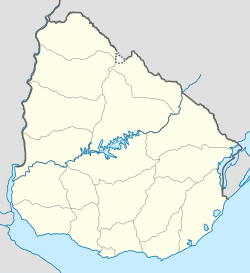Punta del Este
From Wikipedia, the free encyclopedia
| Punta del Este | |
|---|---|
| — City — | |
| Port of Punta del Este | |
| Coordinates: 34°58′0″S 54°57′0″WCoordinates: 34°58′0″S 54°57′0″W | |
| Country | |
| Department | Maldonado Department |
| Founded | 1907 |
| Government | |
| • Mayor(Alcalde) | Martín Laventure (National Party (Uruguay)) |
| Population (2004) | |
| • Total | 7,298 |
| • Demonym | Puntaesteño |
| Time zone | UTC -3 |
| postal code | 20100 |
| Area code(s) | +598 42 |
Contents |
History
The first Europeans to set foot in what is now Punta del Este were the Spanish at the beginning of the 16th century. However, the colonization of the area actually began around Maldonado at the end of the 18th century due to Portuguese expansionism.[citation needed] Punta del Este and its surroundings (Maldonado and Punta Ballena for example) at the end of the 19th century were kilometers of sand and dunes, but in 1896 Antonio Lussich bought 4,447 acres (1800 hectares) of uninhabited land and there he started a botanic garden and planted trees and plants from all over the world.[citation needed] Later the trees started to spread on their own, and now the area is full mostly of Pines, Eucalyptus, Acacias and various species of bushes. Its status was elevated to "City" category 2 July 1957 by decree Ley No. 12.397.[3]Punta del Este hosted an American Summit in 1967 attended by U.S. President Lyndon Johnson.[4] In September 1986, Punta del Este played host to the start of the Uruguay Round of international trade negotiations. These negotiations ultimately led to the creation of the World Trade Organization in 1994.




